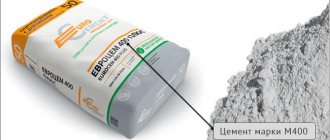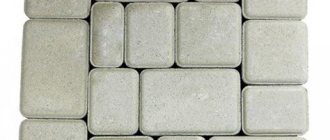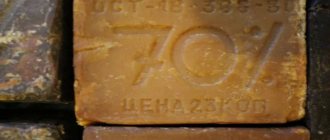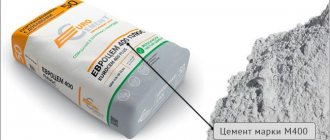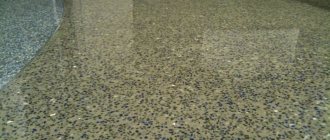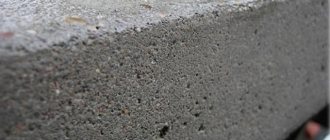Please note: this material is dedicated specifically to the types and properties of additives for cement, not for concrete. What is the difference?
- Concrete is made by mixing 4 components: water, cement, large and small aggregates (crushed stone / gravel, pebbles).
- The mortar (cement and sand mixture) includes 3 components: sand, cement and water.
It is the presence of large fractions in concrete and sand in mortar that is the main difference between the materials. This difference accordingly affects the scope of their use: concrete is used for the construction of large / medium-sized structural elements and foundations; cement-sand mortar - for plastering surfaces, filling joints, constructing screeds for floor coverings.
Types of additives for cement: features, dosage, use
In order to choose the right product for the implementation of your tasks, it is important to know the characteristics of each substance. According to GOST 24640-91, additives for cement are divided into the following types: plasticizing, air entrainers, mixture set accelerators, set retarders, compactors, corrosion inhibitors, antifreeze, polymer, coloring.
Let's take a closer look at each type:
Plasticizing
Advantages
A plasticizer is a special product in the form of a powder, liquid or ready-to-use solution, which, when added to a cement mixture:
- increases the degree of elasticity and fluidity;
- increases the hardness and strength of a monolithic structure up to 125-140%;
- reduces the concentration of water in the solution by 5-15%;
- increases resistance to temperature fluctuations;
- reduces the percentage of material shrinkage after hardening;
- increases adhesion between the components of the cement mortar and with metal products;
- prevents the occurrence of corrosion formations on fittings and other elements;
- reduces the amount of cement used in mortar by up to 15%;
- reduces the likelihood of air voids;
- increases the total coverage area by reducing the thickness of the solution poured;
- improves workability and saves labor resources.
In addition, plasticizing additives make cement more homogeneous, holistic and durable. Thanks to this, the material does not delaminate, does not become covered with a “network” of cracks, and is stored longer before use.
Important! When carrying out construction work at low temperatures (-10°C and below), it is not recommended to greatly reduce the amount of cement in the solution.
Types and areas of use
Depending on the effect they have, plasticizing additives for cement are divided into 4 groups:
- Super strong - capable of increasing mobility by 3-4 times and the plasticity of the solution by several levels (for example, from P1 to P6) without reducing the strength and density of the material. The product is made on the basis of sulfuric acid, 30% formaldehyde, naphthalene and sodium sulfate. Super-strong plasticizing additive for cement is suitable for any construction work: pouring, screeding, plastering.
- Strong - a substance made on the basis of acrylic polymers, inorganic salts, lignosulfonate. Strong plasticizers increase the workability of the cement mixture, increase thixotropy and plasticity by 3-4 levels (from P1 to P3). Recommended for use in molding various structures, screeds and plaster.
- Medium – an additive that increases the waterproofing properties of cement; improves resistance to sulfates and chlorides; increases the mobility of the material from P1 to P3. Medium plasticizers are traditionally used for building foundations and laying plinths.
- Weak - a product created from sodium, fluorine and potassium methyl siliconate increases the plasticity of cement by only 1 level, but at the same time significantly improves its waterproofing characteristics. It is advised to choose weak additives if you need to build small cement structures.
All classes of plasticizing additives increase the density of cement, due to which it conducts heat better (especially important when used for screed under heated floors).
Additive dosage per 100 grams of cement
The dosage of the product depends on its concentration - it is different for each manufacturer. As a rule, this is 0.5-1% of the substance from the total mass of cement - that is, 0.5-1 g of additive is needed per 100 grams of solution. Plasticizers are diluted with water in a ratio of 1:2 (t - up to 30 degrees), and then added to the cement mixture during the mixing process (dry - at the beginning, liquid - in the middle).
Let's look at an example:
when using 0.5% additive by weight of cement - it is necessary to add 100 g of plasticizer for every 10 liters of water
Important! The plasticizer contains substances that are “afraid” of water, so the product should be stored in a dry place at any temperature.
Video: CemThermo complex additive for pouring floors and screeds
Video: Trying plasticizer and hardening accelerator from Cemmix for the first time
Video: Plasticizer for WARM FLOORS CemThermo+ FIBER Cemmix= KNEADING+ STRENGTH check.
PVA glue or liquid glass: what and why is added to the cement mortar
We will send the material by email
- Properties of additives
- PVA
- Liquid glass
- When to use
- How to properly dilute
- Technology for PVA
- Method for liquid glass
- Conclusion
To improve the quality of the mortar, additives are used. A correctly selected component increases the resistance of concrete to loads and reduces the hardening time. Before using cement with PVA or liquid glass, you need to understand the characteristics of the materials.
Air entrainers
Advantages
Thanks to the use of an air-entraining additive, cement becomes more porous, which increases the frost resistance of constructed structures by 2 or more times. Why? Because frozen water expands into the resulting microscopic pores, and not into the thickness of the cement. That is, the main task of the additive is to create a microporous structure in the cement mortar.
In addition, air-entraining additive for cement:
- makes the solution more homogeneous, plastic and mobile by 15-30%;
- increases the degree of water resistance;
- increases resistance to aggressive environments and salts;
- reduces density by 50...150 kg/m3;
- prevents an increase in internal pressure;
- reduces cracking;
- helps reduce the degree of stratification of the solution;
- eliminates the appearance of corrosion on the fittings.
Cement mortar with air entrainment has improved workability.
Dosage
The product is introduced into the mortar in small doses. The concentration is indicated on the product packaging. As a rule, the calculation is made according to the principle: 0.05-0.20% of the additive from the total mass of the mixture.
It is recommended to dilute the additive in water and pour it directly into the concrete mixer when mixing the mortar.
Important ! An overdose of air entrainer leads to a decrease in the strength of the structure (an increase in air content by 1% reduces the strength of cement by 5.5%).
Scope of use
An air-entraining additive for cement is used for:
- construction of road, airfield and bridge structures;
- performing plastering and masonry work.
PS The product should be stored in a tightly closed container, in a place protected from sunlight and frost.
Mix accelerators
Advantages
The main purpose of this cement additive is to speed up the hardening process of the solution. At low ambient temperatures, the setting time of the mixture increases, and in severe frost it stops altogether (due to crystallization of the water included in the solution). Moreover, when thawing, the building material loses quality: it becomes more prone to cracks, poor compaction, and shrinkage.
Thanks to the accelerator, the procedure goes faster. This allows you to do multi-layer pouring in a shorter time, which significantly saves labor and money costs.
At the same time, other quality characteristics of the building material are improved:
- mobility increases;
- strength increases by 25%;
- resistance to moisture improves by 3 times and temperature changes;
- workability increases.
The product is available in powder or liquid form.
Dosage
Indicated on the packaging. Can vary from 0.02 to 5.0% of the total mass of the cement mixture.
What is it used for?
The accelerator should be added to cement:
- If necessary, build a large number of structures in a short time.
- When construction is carried out at ambient temperatures below 0°C.
- In a situation where it is not practical to wait 28 days for the solution to completely harden.
The additive is also used when solving non-standard construction problems, for example, pouring a monolithic pool bowl.
Important ! The accelerator contains chemical elements, so it is not used together with reinforcement, nor is it combined with other cement additives.
Video: CemFix concrete hardening accelerator
Retarders
Advantages
As the name of the additive suggests, it is used to slow down the hardening process of cement. That is, thanks to this product, the setting of the solution is paused, prolonging the “survival” of the finished composition.
In addition, when using the product:
- workability is maintained;
- the mixture is highly mobile;
- Cement costs are reduced;
- strength increases;
- shrinkage is reduced;
- the surface quality of the finished project improves.
This is an important additive that allows for trouble-free cementing and the erection of strong monolithic structures.
How does it work?
Once in the solution, the additive begins to inhibit the hydration of cement. Lime in the material is released more slowly, which slows down the process of binding the grains.
Dosage
As for the percentage of the additive to the total mass of cement, it is determined experimentally on small volumes of the mixture.
Why use retarders?
It is advisable to use a cement additive when:
- It is necessary to transport the cement mixture over long distances.
- There is no way to quickly pour cement.
- The technical process is designed for the gradual use of the mixture.
- Large areas need to be cemented.
- Gently build a precast cement structure.
Retarders are also used to create exterior wall panels.
Video: surface concrete retarder
Compaction additives
Advantages
The main property of the product, also known as a “colmatizing additive,” is an increase in the density of the material, which in turn has a positive effect on the service life of the mixture. How does it work? The additive fills the space between the grains of cement, thus increasing its density, strength and water resistance.
When adding the product, the cement becomes more:
- uniform and smooth;
- frost-resistant;
- wear-resistant;
- durable.
Cement with a compacting additive is less susceptible to aggressive environmental influences.
Dosage
Recommended proportions, according to practical studies: from 0.1 to 0.12% of the additive in liquid form of the total mass of the cement mortar. The dosage may vary to a greater or lesser extent depending on the requirements for the solution.
Area of use
It is recommended to introduce a compacting agent at the end of mixing or together with the mixing water. From the moment the product is added, the solution should be stirred for at least 30 minutes.
The compacting additive for cement is suitable for the production of:
- drainage products;
- paving slabs;
- cement pipes;
- wall blocks;
- drainage trays.
The product is also actively used for waterproofing structures that are operated in conditions of high humidity. For example, these could be: tunnels, hydraulic structures, water tanks, cellars/basements.
PS If the cement additive is frozen, it can only be used after it has completely thawed at room temperature and thoroughly mixed.
Video: complex compacting additive for pouring floors and screeds
Corrosion inhibitors
Advantages
The use of this additive for cement can significantly slow down or completely stop the process of corrosion formation on metal products. Thanks to this property, the steel elements of the structure are protected from corrosion and, accordingly, subsequent complete destruction.
When corrosion inhibitors are added to cement, the following changes occur:
- mobility increases;
- the possibility of hardening at low temperatures increases;
- electrical conductivity increases.
The additive also slightly improves the strength of the material.
How does it work?
Corrosion inhibitors form an oxide film at the junction of cement and metal. The passivating film, while reliably protecting metal structures from oxidation, does not affect the quality of the cement mortar.
Dosage
It is important to correctly calculate the dosage of the product, since an insufficient amount will not work, and an excess will negatively affect the quality of the cement mortar itself. Therefore, it is important to strictly follow the recommendations prescribed by the product manufacturer.
Scope of use
Cement with a corrosion inhibitor is used for:
- protection of steel reinforcement, which are used in aggressive environments (gas, sea water);
- repair of reinforced concrete structures that have suffered from the influence of aggressive environments;
- replacement or restoration of the protective layer of cement.
Important ! Corrosion inhibitors cannot be used in conjunction with chlorides, as they destroy the oxide film. In addition, over time the substance may leach out and the iron/steel will begin to rust. A layer of waterproofing will help avoid this.
Anti-frost
Advantages
The main task of an anti-frost additive for cement is the ability to perform cementation at low temperatures without additional heating of the poured coating.
According to laboratory studies, antifreeze agents also:
- increase density;
- improve water resistance;
- increase design strength.
Depending on the type of additive, cement can be used at temperatures down to -25°C.
How does it work?
The essence of cement mortar hardening is the hydration of the cement, i.e. crystallization of minerals present in cement (aluminates, silicates) when interacting with water. The rate of hardening directly depends on the ambient temperature. In cold weather, this process is significantly extended in time or stops completely due to the fact that the water simply freezes.
Thanks to the antifreeze additive for cement, the liquid begins to crystallize not at 0 degrees, but already at negative temperatures.
Dosage
With a small percentage of the additive, the hydration of cement will be stopped; with an excess, the quality of the solution will decrease. On average, the amount of anti-freeze additive is 2-4% of the total mass of cement (the lower the ambient temperature, the more additive is needed).
An antifreeze agent is introduced into the cement mixture along with water, and for this purpose it is recommended to warm up the liquid a little.
Scope of application
The product is suitable for the following construction tasks:
- screed and plaster;
- construction of monolithic structures;
- improvement of technological characteristics of masonry mixtures.
Important! When using an antifreeze additive, the strength of cement at subzero temperatures is only 30% of the overall design indicators. The remaining 70% of the solution is collected during thawing. Therefore, structures erected in winter should not be heavily loaded.
Video: antifreeze complex additive CemFrio
Polymer
Advantage
The use of a polymer additive makes it possible to improve the quality properties of cement, namely:
- waterproof;
- bending strength;
- density;
- elasticity;
- frost resistance;
- adhesion to reinforcement.
Polymer cement has 60-70% less shrinkage than mortar without additives. The product is non-toxic, odorless and non-flammable.
How does it work?
The polymer additive forms a thin polymer film on the surface of the cement grains, which firmly glues the particles together, creating a reliable monolithic mixture.
Dosage
The polymer agent is introduced into the cement mixture with mixing water in a ratio of 20% of the total mass of cement. But for each manufacturer, the dosage may change up/down, so read the instructions before use.
Where is it used?
Cement with a polymer additive is used for:
- creating a screed;
- restoration of cement coating.
PS The compatibility of polymer cement additives with other types of additives should be verified practically.
Video: Making lightweight polymer concrete
Coloring
Advantages
The coloring additive serves to “color” the usual gray cement into a different desired color. It can be introduced at the stage of mixing the solution, then even if the top word is damaged, the color will not change. Another option is applying a coloring agent to the surface of an already hardened solution - not a very reliable solution, but cheaper in comparison with coloring the mass.
High-quality coloring additives:
- do not fade in the sun;
- provide uniform coloring;
- do not wear out or wear out for a long time.
The most common additives are in the following colors: orange, brown, green, red, blue. By mixing colors, you can create your own unique shade.
Dosage
Depends on how rich and deep the color of cement is needed. The more water is introduced, the lighter the color will be. Most often, 8-10% of the total mass of cement is added, but it is possible to use: 1-3% - to obtain a pastel tone; 3-4 – colors of medium intensity; 4-6% - deep shade.
Scope of application
The product is used to make boring cement structures more vibrant and colorful. Popular when creating urban landscape design and beautifying private households.
Made from colored material:
- garden and paving slabs;
- side stone;
- filling of playgrounds;
- all kinds of sculptures, etc.
Please note: the product is available in the form of an emulsion, liquid, dry mixture, paste, microcapsules. But the most affordable is powdered dye.
Video: about dye for concrete
Video: how to mix a colored concrete solution for paving slabs
Video: preparing colored concrete for paving stones and tiles
Dyes
Used for tinting cement mortar to the required color during the production of tiles, borders, sculptures, artificial stone, paths by pouring. If the coating cracks or the top layer is damaged, the color of the base will not change. The additive evenly colors the entire mixture, does not fade in direct sunlight, and does not wear off due to mechanical stress. Saturation depends on the amount of tonic and water. The dosage is selected depending on the desired effect:
- for pastel color - 1-3%;
- saturated tone - 4-6%;
- average depth - 3-4%.
Important! The average consumption is 8-10% by weight of the cement mixture. Applying dye to hardened cement products does not provide light fastness and reliable coloring for a long period.
How to make a cement additive at home?
Resourceful inventors have come up with recipes for making cement additives with their own hands.
We offer the most popular methods:
Antifreeze additives
The most common options are the use of sodium chloride or calcium chloride salts, which significantly lower the freezing point of water in the mortar and, therefore, reduce its setting time.
The downside is that it cannot be used when working with reinforced metal, since salts contribute to corrosion.
Plasticizer
The factory product can be replaced:
- Shampoo or liquid soap. To do this, you need to add 200-250 ml of detergents per 50 kg of cement and mix well. In this case, you should reduce the amount of water added to the solution by the volume of shampoo/soap added, otherwise the mixture will harden for 3 hours longer.
- Washing powder. Add 100-150 g of powder to a bag of cement (50 kg), after dissolving it in warm water. Mix everything thoroughly.
Shampoo or liquid soap is poured in first.
Disadvantages of homemade plasticizers: salt stains appear on the surface, there is no water-repellent film, and there is a high probability of mold and mildew.
You can also use as a plasticizer: slaked lime (up to 15-20% of the total mass of cement) and PVA glue (200 g per bucket of mixture).
Hardening accelerator
There are quite a few recipes. The most effective, which is more suitable for use in production, is treating the cement surface with saturated warm steam. Without the necessary equipment, it is possible to organize the heating of the formwork or cement itself by laying loops of PNSV or electrodes before pouring the cement.
The disadvantages of this recipe are the inconvenience of laying the cable/electrodes and the high probability of their damage, which will render the entire heating system unusable. Warming up with electrodes is also a very energy-consuming activity.
Video: how to speed up concrete hardening
Cooperation with AlfaCem
For questions about choosing the right type of additive and the nuances of use, we recommend contacting our managers. We offer a wide range of cement strength additives from well-known brands. The advantages of our services include:
- large selection of goods at wholesale prices;
- delivery from a warehouse in Moscow in a convenient way;
- free consultation on the selection and purchase of materials;
- ensuring the smooth operation of your production.
All materials undergo laboratory testing. Their safety and compliance with construction regulations is confirmed by relevant certificates. We are ready to help with all organizational issues regarding the goods purchased from us. You can contact our managers by telephone or through the feedback form.
Chemical additives for different cement mixtures
Chem. additives allow the production of different types of cement with different characteristics.
Thus, 5% aluminum oxide is used to create sulfate-resistant Portland cements (SPC), as well as all cements based on aluminous (high-alumina) clinker. Aluminum oxide acts as a setting and hardening accelerator. Other intensifiers include: potash, sodium sulfate, calcium nitrate, calcium chloride . When using setting accelerators, it must be taken into account that some loss of final strength is possible.
An important additive for the creation of acid-resistant cements containing fillers - sodium fluoride silico . This is a hardening accelerator, which further affects the strength of the material, its heat and temperature resistance, water and acid resistance. But you cannot overdo it with the addition of this substance, because its excessive introduction can lead to a decrease in the mechanical strength of the material, loss of water resistance and too rapid setting, which greatly complicates the work process. The optimal volume is 4-6% of the weight of the filler.
To create heat-resistant cements, you can use an additive such as liquid sodium glass . It also accelerates hardening and, in large quantities, allows for high waterproofing. However, there is a very fine line between large and excessive volumes, which, as is the case with other intensifiers, can ultimately lead to a loss of strength. This should be watched very carefully.
Don’t forget about antifreeze additives, which allow you to work with cement at low temperatures. A striking example is calcium chloride , which, moreover, accelerates setting and hardening under normal conditions, and also helps to revive stale cements. Alternatively, potash, urea, sodium nitrate or calcium nitrate . The latter substance acts on the material as a whole, allowing not only to carry out work in cold weather, but also to accelerate the development of strength, prevent the formation of cracks, slow down the corrosion of reinforcement, and obtain high-quality surfaces.
In the cement industry, there are also superplasticizers - synthetic substances used in the amount of 0.1-1.2% by weight of cement. They are characterized by a strong diluting effect, the duration of which is limited to 2-3 hours from the moment of addition. The most common superplasticizer is sodium sulfate .
Obviously, mineral, like chemical. additives for cement production are of great importance in this industry. They not only affect the material itself, but also determine the properties, characteristics and durability of structures built using it. Therefore, it is important to treat their selection and use with full responsibility.
Still have questions about this topic? Can’t decide on your own which additive to use for a specific type of cement or to perform any task in the mixture? Contact us! Our specialists will be happy to help you with this!
Fluffy (lime)
Ordinary slaked lime is also excellent for increasing the consumer properties of concrete mortar. This recipe comes from the Soviet era, and at that time, as you know, they built to last. It has a beneficial effect on the quality of concrete, making the solution more elastic and sticky. When using lime, working with concrete becomes easier and more enjoyable.
Here it is important to draw the readers’ attention to another useful feature of slaked lime - its bactericidal properties. By adding it to concrete, you will get a mixture that is resistant to fungi and mold. This recipe is recommended for use in cases where it is necessary to carry out work in rooms with high dampness.
The last folk supplement that deserves attention. At first glance, ash does not inspire confidence, but keep in mind that it is an environmentally friendly product. A small amount of ash helps make concrete strong and flexible. This mixture is perfect for renovation work in an apartment or private house.
As you can see, there are many folk additives that help you obtain professional concrete at home. Which recipe to resort to is up to you. The main thing is to remember something else: in the pursuit of cheapness, it is important not to forget about quality and further operating conditions. This will help you find a middle ground.
Technology
The raw materials are crushed into tiny particles in mills and then sent to roasting, where either liquid or gaseous fuel is used. It is unacceptable for ash or soot to enter the composition. After this stage, the clinker is sent for cooling in an oxygen-free environment or very cold water. Next, it is dried in a special drying drum at a temperature of 350 degrees.
Cement is produced in only 3 grades. The grade is determined by the whiteness of the finished product.
White cement has a number of advantages:
- High strength and rapid hardening of the solution.
- Does not collapse when interacting with various chemical elements.
- Environmentally friendly, as only natural substances are used in the composition.
- Multifunctionality. White cement is used both as a construction and decorative material.
How to prepare cement mortar with your own hands?
How to prepare cement mortar with your own hands?
Almost any repair, and certainly not a single construction project, can do without the use of cement. Creating a foundation, forming block or brickwork, plastering walls, wiring electrical networks and any other communications require the use of this material. Without cement, it is impossible to prepare concrete or mortar. And even a completely inexperienced person, following fairly simple instructions, will be able to prepare cement mortar, high-quality concrete mortar of various grades from M100 to M500.
How to identify a brand?
It's very simple: the grade of cement is divided by the amount of sand. As an example, we give several options.
- grade 400 cement is used , then the ratio between cement and sand is one to four; for one bucket of cement, four buckets of sand are taken.
- When using grade 500 , the ratio changes to one to five; five buckets of sand are added to one bucket of cement.
- If a mortar of grade 200 , the ratio between cement and sand will be one to two. So to one bucket of cement 400 two buckets of sand are added.
To the resulting mixture it will be necessary to add water and detergent in a certain order (few people know about this component, we will talk about its significance a little below) and obtain the required brand of solution.
Determining the required brand of solution
Theoretically, the brand of mortar used should match the brand of material used (blocks, bricks, etc.). So, for example, if brickwork is being built, and the brand of brick used is 100, then, ideally, the brand of mortar should match this number. The result is an almost homogeneous solid brick structure.
However, it is far from necessary to go too far and strive for absolute coincidence. If a facing brick corresponding to grade 350 is used in the construction of a house, the mortar does not have to be made according to the above formula.
Typically, for facing brickwork, a mortar with a grade corresponding to approximately 115 is used. To make it, two parts of cement to seven parts of sand (1/3.5) are laid in one batch. After about three weeks, after final drying, it is very difficult to hammer a nail into the seams of such a solution.
You should not think that an increase in the number of the brand of a solution necessarily leads to an increase in its quality. When mixing one to three, the solution will set too quickly and therefore it will not be very convenient to work with it. If the batch is done one to four, the seams of the facing brick will begin to crumble over time.
When constructing partitions from backfill bricks, the grade of which corresponds to 75, the solution used can also correspond to 75 (5.3 parts of sand are taken for one part of cement). And during construction from blocks (cinder blocks, shell rock, etc.), mortar grade 100 is usually suitable.
Step-by-step process for preparing cement mortar
There are many ways to prepare solutions. We will describe the highest quality, fastest and optimal of them.
Water
If you are preparing not a dry mixture, but a classic ordinary solution in a concrete mixer, first of all you need to pour water into it. However, its exact amount cannot be determined in advance and one should not rely on any formulas. So, for example, the amount of water will decrease if wet sand is used. The simplest way to make a preliminary calculation is to focus on the amount of cement. For example, if a batch requires one bucket of cement, approximately the same amount of water will be required - about one bucket. In order not to get an excessively liquid solution, it is better not to overdo it with the amount of water and fill it a little less than the required amount.
At the same time, if there is too little liquid, you will have to constantly add water, then add cement or sand. This will lead to a significant lengthening of the process of preparing the solution. If the types are poured quite a bit less than the norm, mixing sand with cement in a liquid state will happen much faster than in the case of a thick solution.
When the last components of cement and sand are added to the concrete mixer, the remaining water is added by eye. In order for sand and cement to be mixed better and faster, they must be in a liquid state. And the required density of the solution is adjusted at the end of the batch.
When more water is added than required and the solution turns out to be too liquid, nothing bad will happen. You just need to add a little cement and sand in the same proportions required for this brand (1:4, 1:3, etc.).
Detergent
Not a very common additive, which, nevertheless, is very useful and significantly improves the quality of the resulting solution and makes it elastic. It is best to add liquid soap or dishwashing detergent. Quality (let alone brand awareness) is not particularly important, the main thing is that the product foams. If the amount of the required solution is not too small, it is best to buy them in large five-liter plastic bottles, they are cheaper than small ones.
While preparing the solution, approximately 50-100 grams of detergent are added to the mixer. Its exact quantity cannot be determined, since it depends on various factors.
This component is added after the water is poured in, then good dissolution and foaming will occur. For final dissolution and foaming in a running concrete mixer, three to five minutes are enough. If you add detergent at the end of the kneading, the dissolution will be poor and the elasticity will hardly improve.
Sand
Sand should be added next to the detergent (after it is well dissolved). However, it is not poured all at once, but half of the total amount required for the entire batch. So, if a mortar of grade 100 is prepared using cement 400, two of the required four parts are poured into the first fill.
Cement
After half of the added sand, cement is poured into the concrete mixer - the entire amount required for mixing. After this, you need to wait a couple of minutes for it to be completely mixed with water and sand.
Sand
When all the cement in the concrete mixer is completely mixed with other ingredients, the remaining sand is added to the resulting mass. If necessary, the missing part of the water is added and at the end of the process the density of the solution is adjusted. After this, the solution is finally mixed for three to five minutes.
As a result, the resulting solution should be neither too thick nor too thin. Its consistency should be similar to store-bought sour cream. The shape of the solution should hold fairly well. To check, you can try to write or draw something on its surface. The written letters should not blur.
Summary: preparing a good double-mix mortar in a concrete mixer (approximately eight buckets of ready-made sand-cement mixture) requires only about fifteen minutes.
Quality of materials required for a good solution
Pure water
In theory, dirty water such as oily water or rainwater should not be used to prepare the solution. But in reality, such strict rules are applied in the construction of critical structures and buildings (bridges, nuclear power plants, and the like). If civil buildings are being constructed (residential buildings, dachas, etc.), then the requirements for the purity and quality of water are not so strict. Typically, water from the water supply, from wells or wells, and sometimes from rivers or lakes is used to prepare the solution.
Detergent
Adding detergents improves the elasticity of the solution and prevents it from shrinking. Any detergent, but not cleaning agents, can be used. In principle, it can be washing powder, white clay, laundry soap or even shampoo. There is a certain nuance: if too much detergent is poured into the batch, the solution may lose strength. The fact is that exceeding the amount of detergent will make it airy and foamy. The solution will contain too many air bubbles and will look like cotton wool. Therefore, when adding detergent, you should not overdo it, so as not to reduce the strength of the solution.
Sand
It is very important, especially for facing masonry, that the sand for the mortar is of normal quality and does not contain clay. If you use clay sand, then over time the seams of the facing masonry will be covered with holes. The clay that gets into the solution along with the sand comes out, where it is washed out by rain and forms voids. Whether sand is good (without clay) or not is easily determined visually. So, if the color of the sand is too yellow, then it is not washed, quarry, and contains too much clay. This material is suitable for backfill or for dirty, backfill masonry. But you shouldn’t use it for the front. It is also not advisable to use sand that is too clayey for critical concrete (for lintel crossbars, reinforced concrete belts, etc.)
If the sand is washed, then it contains a very small (or completely absent) amount of stones and clay. The color of this material is much closer to white. Alluvial sand is used for critical concrete and for facing masonry.
Carbonate rocks
Let us dwell on carbonate rocks, the typical representatives of which are:
- Chalk, which is a sedimentary rock that is easily ground, belongs to a variety of smearing limestone. It is popular in making cement.
- Marl or marly limestone are sedimentary minerals that are mined in a loose or solid state and differ in specific gravity and moisture concentration. They contain clay impurities, which allows them to be classified as a transitional raw material, which has much in common with limestone rocks and clay-based fossils.
Contains active mineral additives (15%) in accordance with production standards

